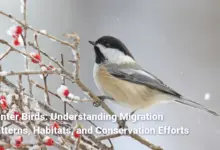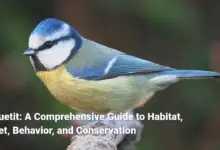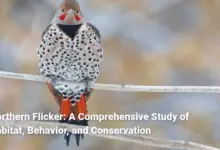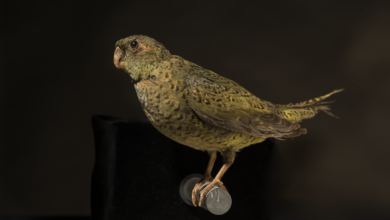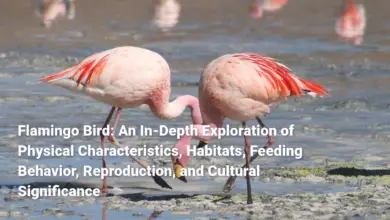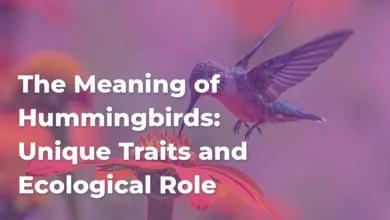The Yellow Cardinal Bird: Overview of Appearance, Behavior
Exploring the Coloration, Vocalizations, Distribution, and Conservation Efforts of the Yellow Cardinal Bird
Yellow Cardinal Bird
The yellow cardinal bird, amidst the tapestry of avian variety, stands out vividly with its stunning plumage and intriguing behaviors. This cardinals’ gem, scientifically known as Gubernatrix cristata, represents a rare color mutation of the northern cardinal. Where the northern cardinal boasts its iconic crimson hue, the yellow cardinal dons a coat of bright yellow resulting from a fascinating genetic anomaly known as xanthochroism. This mutation inhibits the production of red pigments while allowing for the development of yellow pigments instead. As a result, these birds are not just a treat for the eyes, but they also stimulate curiosity and admiration among bird watchers and researchers alike.
The story of the yellow cardinal is one of beauty and rarity, as sightings are exceptionally elusive, occurring at a rate of approximately only 10 to 15 known individuals across North America. Beyond breathtaking aesthetics, yellow cardinals possess a rich behavioral ecology, social structure, and cultural significance. They embody hope, joy, and uniqueness a symbol of individuality within the natural world. Thus, this article delves deeply into their characteristics, behaviors, conservation, and cultural implications, shedding light on the charm and rarity of the yellow cardinal bird.
Appearance and Identification of Yellow Cardinal Bird
Yellow cardinals exhibit vibrant yellow plumage that commands attention, painting them as bright beacons in the avian world. A fantastic comparison would be to see a yellow cardinal against the backdrop of a lush green lawn its brilliant feathers almost reminiscent of the sun breaking through swathes of clouds. Unlike the unmistakable brilliant red of their northern cardinal cousins, the yellow cardinal’s coloration invites wonder and enchantment among those who catch a fleeting glance.
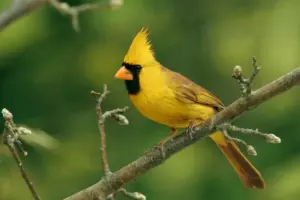
These birds typically measure around 8.2 to 9.3 inches in length, comparable to the size of a standard roadway sign, while their wingspan spans from 10 to 12 inches, allowing them easy maneuverability through various environments. Despite their remarkable appearance, some bird watchers may initially mistake yellow cardinals for sparrows or other yellow-hued birds due to their unique coloration and shaping.
Distinctive features help in identifying yellow cardinals away from confusion:
- Color: Bright yellow feathers, replacing red pigments.
- Beak: Thick, orange-red, cone-shaped bill similar to red cardinals.
- Facial Mask: A lesser pronounced black facial mask than seen in male northern cardinals.
In terms of sexual dimorphism, male yellow cardinals typically exhibit more vibrancy in their plumage than females; the latter may demonstrate some muted brownish or grayish patterns that create subtle variations in appearance. Understanding these identification traits enables bird enthusiasts and casual observers alike to celebrate the extraordinary uniqueness of yellow cardinals while appreciating their fascinating roles within the ecosystem.
Coloration and Plumage of Yellow Cardinals
One cannot overlook the mesmerizing brilliance of a yellow cardinal in full sun its feathers seem to glow, capturing the natural light in an almost magical way. The captivating coloration of yellow cardinals stems from a genetic mutation disrupting the typical production of red pigments associated with northern cardinals. Instead of the rich reds that speak of vibrant energy, these birds showcase a dazzling array of yellow hues, thanks to the effective deposition of carotenoids such as lutein and zeaxanthin in their feathers. This alteration in pigment chemistry leads to a striking golden-yellow appearance that draws attention and fascination.
The rarity of these birds adds another layer of intrigue to their colorful plumage. Estimates suggest that yellow cardinals account for less than 1% of the cardinal population, marking them as exceptional avian gems amid their more common red relatives. Bird watchers often report thrilling experiences while spotting these bright variations, likening such encounters to finding treasure hidden within vines of a lush forest.
The yellow cardinal’s feathers also reflect the nuances of sunlight; they may appear more pale or muted under cloudy skies, and yet, during bright conditions, they exude warmth and brightness reminiscent of spring blossoms. Encounters with these birds remind us of the transformative beauty found in the diversity of life, reinforcing the significance of maintaining healthy ecosystems where such anomalies can flourish.
Sexual Dimorphism in Yellow Cardinal Birds
Sexual dimorphism among yellow cardinals unveils intriguing aspects of their biology. In the realm of avian species, differences in male and female appearances often play a critical role in mate selection and reproductive behaviors. For yellow cardinals, this is no exception. Male yellow cardinals typically showcase more pronounced and vibrant yellow plumage compared to their duller female counterparts. Their bright coloration serves as a beacon not only conveying fitness to potential mates but also establishing their presence within established territories.
To paint a clearer picture of the sexual differences, consider the following comparisons:
- Coloration: Males shine in brilliant yellow, while females may depict softer, more muted shades.
- Aggressiveness: Males often engage in more territorial displays, whereas females are typically involved in nurturing breeding responsibilities.
- Vocalization: Males are more vocal during breeding rituals, exhibiting a symphony of whistled tunes, while females tend to have lesser vocal displays.
Interestingly, yellow cardinals maintain similar body structures amongst the sexes, characterized by thick, wedge-shaped bills designed for seed cracking a functional adaptation shared with northern cardinals. The social behaviors observed also reflect their dynamic relationships during breeding; both parents partake in food gathering responsibilities, promoting greater survival odds for their young. Overall, the sexual dimorphism within yellow cardinals is not just visually striking but also embodies the intricate patterns of survival and reproduction in the avian world.
Unique Features Compared to Red Cardinals
Comparison between yellow and red cardinals provides insights into the unusual nature of yellow cardinals. Though both share similarities, the differences paint a vivid picture of avian diversity.
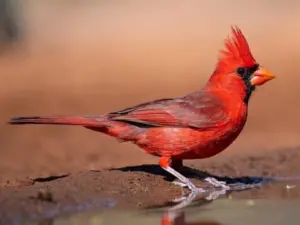
| Feature | Yellow Cardinal | Red Northern Cardinal |
|---|---|---|
| Color | Bright yellow | Deep red |
| Size | Similar in size, 8.2 to 9.3 in | Similar in size |
| Sexual Dimorphism | Males more vivid than females | Males bright red, females brown |
| Distribution | Primarily U.S. and South America | Widely across U.S. and Canada |
| Rarity | Less than 1% of cardinal population | Common, easily spotted |
One striking contrast lies in their coloration; yellow cardinals bring forth the unexpected with their sunlit feathers, while the northern cardinal bird commands attention through its bold red hue. Unlike yellow cardinals, males of the red variety boast a striking, bright red plumage adorned with a pronounced black mask. In addition to their color differences, habitat and behavior comparisons reflect further distinctions. Yellow cardinals may attract more intrigue due to their rarity, as they are often likened to precious jewels in the realm of birds created by nature’s quirks, polar opposites of the more prevalent red species.
Ultimately, exploring these contrasts emphasizes the rich palette of avian life and the distinct tales each bird tells through its uniqueness, inviting a deeper understanding of biodiversity and ecological balance.
Behavioral Characteristics of Yellow Cardinal Bird
Yellow cardinals exhibit captivating behavioral traits that enhance their allure. Framed by vibrant plumage, their interactions not only engage observers but also create fascinating dynamics within their ecosystems.
- Courtship Rituals: Male yellow cardinals engage in elaborate mating rituals marked by intricate singing and vivid displays of plumage to impress potential mates. These rituals often include hop-and-flash dances, where males showcase their colors against green backdrops to signify readiness to mate.
- Territorial Behavior: Yellow cardinals are known for theirstrong territorial instincts, particularly during breeding seasons. Males establish dominance by defending their chosen habitats vigorously, utilizing both vocal threats and physical displays to ward off intruders, ensuring the safety of their nesting areas.
- Social Interactions: Yellow cardinals typically forage in pairs or small family groups, facilitating collaborative hunting for seeds and insects. Their social structure allows for effective communication, helping them alert family members to predators or potential danger through sharp calls or melodious whistles.
- Adaptation to Environment: Their behaviors can adjust according to environmental cues. For instance, they can alter their vocalizations based on background noise or habitat density, ensuring that communication remains clear amongst family members in various environments.
Through observing these behavioral characteristics, birdwatchers gain insights into not only the yellow cardinal’s adaptive strategies for survival but also the wonder of the natural world, where plumage reflects magnificence while behaviors demonstrate the intricacies of social life and courtship.
Singing and Vocalization
Songs of the yellow cardinal are as enchanting as their vibrant coloration, a blend of whistles reminiscent of melodious spring. The first call crisp and bright can evoke emotions akin to sunrise breaking the dawn after a long night. These vocalizations play a key role in establishing territories, signaling intentions, and attracting mates.
- Song Structure: Yellow cardinals produce a repertoire of whistles and trills, with melodies reminiscent of other cardinals but infused with unique patterns. Their song can vary depending on the season and context, with more elaborate compositions emerging during courtship periods.
- Duets and Pair Bonding: During mating rituals, males and females often engage in duets, harmonizing their calls. These simultaneous vocalizations strengthen pair bonds, signaling their commitment to nesting and joint parenting responsibilities.
- Alarm Calls: In addition to lyrical songs, yellow cardinals communicate through sharp alarm calls short, quick sounds that alert family members and nearby birds of potential threats. This aspect enhances familial cohesion and survival, as it allows for coordinated responses to dangers, from predators to environmental hazards.
- Adaptability in Vocalization: To navigate environmental challenges, yellow cardinals can modify their calls, adjusting volume and pitch to ensure their messages resonate even in dense foliage.
In essence, the singing and vocalization patterns of yellow cardinals exemplify intricate communication strategies that weave together courtship, territory establishment, and family dynamics. Their melodious performances offer bird watchers an opportunity to connect with nature’s beauty and the complex interactions that define avian life.
Foraging Habits
The foraging habits of yellow cardinals reflect a well-adapted approach to obtaining sustenance, showcasing their behavioral flexibility and survival strategies. Much like a culinary artist surveying their landscape for fresh ingredients, yellow cardinals meticulously navigate their environments to find an array of food sources.
- Dietary Preferences: Yellow cardinals predominantly follow a granivorous diet, delighting in various seeds, fruits, and insects. Their favorites include sunflower seeds, berries, and crickets, which provide both energy and vital nutrients. This banquet of nature’s offerings allows them to thrive in differing environments.
- Foraging Techniques: These birds are known for their ground foraging behavior, often hopping along the forest floor in search of fallen seeds and other food items. Yellow cardinals also utilize trees and shrubs, gleaning insects and fruit from their branches a behavior similar to that of their red cousins.
- Family Foraging: Yellow cardinals often forage in pairs or small family groups, enhancing their chances of locating a rich food source. This social aspect of foraging not only strengthens familial bonds but also allows them to share information about food availability and potential dangers.
- Adaptability: Their adaptability in diet allows yellow cardinals to thrive in both urban and natural settings, easily transitioning between garden feeders and wild landscapes, as they search for available food sources. This flexibility is crucial for surviving environmental fluctuations.
Overall, foraging habits in yellow cardinals reflect an intricate balance between dietary preferences, social interactions, and environmental adaptations. Birdwatchers can gain insights into the dynamic relationships these birds cultivate with their habitats while appreciating the charm and complexity of their everyday behavior.
Social Structure and Breeding
The social structure and breeding behaviors of yellow cardinals highlight their collaborative nature, encapsulating the essence of family cohesion and parental responsibilities. Much like a close-knit community organizing for common goals, yellow cardinals exemplify teamwork in nurturing their young.
- Pair Bonding: Yellow cardinals typically form lifelong pair bonds, characterized by courtship displays that often include singing and dancing. Male cardinals showcase their vivid plumage, captivating potential mates. These bonds facilitate collaborative parenting, with both partners equally engaged in caring for offspring.
- Nesting: During breeding periods from March to September, females select nesting sites near bushes, shrubs, or trees, ensuring protection from predators. Together, pairs may utilize twigs, grasses, and other materials to build sturdy nests, reflecting their commitment to creating a safe environment for future generations.
- Parental Responsibilities: Both male and female yellow cardinals partake in feeding their chicks. After a clutch of 2-5 eggs is laid, the female incubates them for about 11 to 13 days while the male provides sustenance. After hatching, both parents actively feed the young, primarily providing insects and seeds until the chicks fledge approximately 9 to 10 days post-hatching.
- Social Interactions: Aside from their primary pair, yellow cardinals are known to join mixed-species flocks during non-breeding seasons. These communal gatherings offer significant advantages, including increased safety from predators and improved foraging opportunities.
The social structures and breeding strategies of yellow cardinals illustrate an intricate web of relationships defined by cooperation and shared responsibilities. Observing these dynamics firsthand provides bird enthusiasts captivating insights into the familial lives of these charming avians, reminding us of nature’s interconnectedness.
Habitat and Distribution of Yellow Cardinal Bird
Yellow cardinals primarily range through the southeastern regions of the United States, weaving themselves into the landscapes of Alabama, Georgia, and South Carolina. While these birds display a certain level of adaptability, their habitat preferences encompass various ecological zones, from dense forests to suburban gardens and parks.
As they flit through these environments, reminiscent of warm sunshine cutting through leafy canopies, they reveal both their resilience and beauty. Although their geographic distribution highlights their preference for dense cover, as is observed in other cardinal species, the yellow cardinal’s survival is significantly influenced by the availability of food sources within these regions.
Preferred Habitats:
- Open Woodlands: Ideal for nesting and foraging, offering coverage to hide from predators.
- Savanna and Shrubby Areas: Provide ample seeds and insects while facilitating territory establishment.
- Suburban Gardens: Engaging with human environments, yellow cardinals take advantage of feeders and garden plants that yield fruits.
The presence of yellow cardinals in diverse habitats signifies their flexibility, posing a reminder of nature’s ability to adapt. Their beauty not only enhances the ecological landscape but also invites conservation efforts aimed at preserving their habitats.
Preferred Environments
Yellow cardinals display notable preferences for specific environments, emphasizing their adaptive tendencies and ecological requirements. They thrive best in a variety of settings, reflecting both their resilience and the need for suitable foraging and breeding grounds.
- Open Woodlands: Yellow cardinals often inhabit open woodlands, which provide shelter and sources of food. These environments allow them to forage effectively while offering cover to evade predators.
- Savannas and Shrubby Steppe: Their affinity for savanna ecosystems is notable, where grasses and low shrubs flourish. This habitat not only supplies ample seeds but also fosters insects, essential for a complete diet.
- Suburban Areas: Interestingly, yellow cardinals have extended their presence into suburban gardens and residential areas. Here, they frequent bird feeders stocked with sunflower seeds or other grains, adapting their foraging behavior to benefit from human-provided food sources.
- Proximity to Water: Access to fresh water sources enhances their habitat suitability, further promoting their survival prospects. They are often spotted near lakes, rivers, and ponds where they can drink and bathe.
By understanding their preferred environments, conservationists can better focus on habitat protection efforts, ensuring that yellow cardinals not only thrive but enrich the diversity of avian life in their ranges.
Geographic Locations of Sightings
Witnessing a yellow cardinal in the wild is a rare privilege due to their limited geographic distribution, primarily located in the southeastern United States and extending into parts of South America. While potential sightings may surprise bird observers elsewhere, the following regions have become notable hotspots for yellow cardinal enthusiasts.
- Southeastern United States: States such as Alabama, Georgia, and South Carolina have become known as habitats for yellow cardinals, where these birds coexist with their more familiar red counterparts. Sightings have been intriguing to birdwatchers in both rural and suburban areas.
- Florida and Mississippi: Reports occasionally emerge from Florida and Mississippi, highlighting the birds’ ability to inhabit diverse landscapes. These states add dimension to the yellow cardinal’s range as they continue to adapt to various ecological settings.
- Tennessee and Kentucky: While sightings of yellow cardinals in these northern reaches are infrequent, they underscore their adaptability. A few instances have been recorded, capturing the excitement of local bird enthusiasts eager to learn more about these unique avian inhabitants.
- Notable Reports: The allure of seeing a yellow cardinal has inspired significant media coverage, with each sighting marked by enthusiasm from both amateur and seasoned birdwatchers. The stories shared like that of “Mr. Yellow” in Alabama demonstrate the profound impact yellow cardinals have on community engagement towards birdwatching and conservation efforts.
The geographic diversity of yellow cardinal sightings enriches the conversation around avian conservation, prompting further exploration and appreciation for these enchanting birds in their ecological niches.
Impact of Habitat Loss
The yellow cardinal’s vulnerability to environmental changes underscores the significance of exploring habitat loss’s far-reaching consequences. As urbanization, agricultural expansion, and climate change progress, the delicate balance of ecosystems that nurture these rare birds faces alarming disruption.
- Urbanization: Human development leads to habitat fragmentation, creating barriers between critical foraging and breeding areas. This encroachment diminishes the available territories for yellow cardinals, which thrive on dense cover to evade predators and engage in social behavior.
- Agricultural Practices: Modern agriculture often involves significant land-clearing and pesticide use, negatively impacting food availability. As yellow cardinals primarily rely on natural sources of seeds and insects, destruction of local flora significantly compromises their dietary options.
- Climate Change: Shifting climatic conditions can impact breeding cycles and food supply at various levels, forcing yellow cardinals to adapt to new patterns. This alteration can place additional stress on small populations that already face survival challenges.
- Conservation Efforts: Addressing habitat loss through awareness and diverse conservation initiatives is crucial for safeguarding yellow cardinals. Protecting natural areas, restoring native vegetation, and fostering sustainable practices can create safe spaces for these bird populations to thrive.
As environmental changes continue to unfold, understanding and mitigating the impact of habitat loss will be pivotal in ensuring yellow cardinals remain visible in the ecosystem, preserving their presence as a symbol of nature’s wonder.
Rarity and Conservation of Yellow Cardinal Bird
The rarity of the yellow cardinal signals a pressing need for conservation efforts, highlighting the unique identity of this bird within the broader context of avian life. Their limited population, estimated to number only 1,500 to 3,000 individuals, is a stark reminder of the fragility of avian diversity.
- Population Estimates: The yellow cardinal population primarily inhabits regions in South America, where habitat degradation and loss further threaten their status. This minuscule population size signifies the urgent need for proactive conservation strategies to ensure the survival of this enigmatic bird.
- Conservation Initiatives: Numerous efforts have been undertaken to support the yellow cardinal’s recovery. The establishment of protected areas, alongside captive breeding programs, emerge as critical solutions. National parks and reserves safeguard habitats, while initiatives to prevent illegal trapping contribute positively to overall population stability.
- Research and Awareness: Ongoing studies are vital in demystifying the ecology and requirements of the yellow cardinal. Understanding their specific habitats, behaviors, and potential threats will inform future conservation strategies while encouraging community involvement in local preservation efforts.
- Public Involvement: As awareness grows surrounding the uniqueness of yellow cardinals, community engagement becomes a powerful tool in conservation. Local birdwatching groups and enthusiasts can foster a culture of appreciation, heightening the importance of protecting natural habitats essential steps towards maintaining the yellow cardinal’s place in the world.
Ultimately, the rarity of the yellow cardinal invites concerted efforts to protect and preserve these remarkable birds, cultivating a brighter future for both their species and the ecosystems they inhabit.
Estimated Population Numbers
Estimated population numbers for yellow cardinals present a concerning picture of this striking bird. As one of the rarest members of the cardinal family, understanding their population viability is crucial:
- Overall Estimate: The total population is estimated to be between 1,500 to 3,000 individuals, translating to a surprising low number of around 1,000 to 2,000 mature birds.
- Rarity in North America: In North America, the occurrence of yellow cardinals is significantly rare, with only about 10 to 15 individuals located across the continent. This decline in population figures sharply contrasts with their more populous red cardinal relatives.
- Threats to Survival: The chronic exploitation for the bird trade, combined with habitat loss and fragmentation, has contributed to this alarming decline in yellow cardinal numbers. As their population dwindles, the urgency for conservation efforts becomes increasingly paramount.
- Monitoring and Protection: With such low estimated numbers, ongoing monitoring plays a vital role in understanding yellow cardinal dynamics. Efforts to protect their natural habitats and educate communities on conservation practices are crucial in safeguarding their future.
The current status of yellow cardinals emphasizes the pressing need for targeted conservation measures that address their unique challenges. By working collaboratively, we can advocate for actions that ensure the longevity of one of nature’s rare gems.
Genetic Mutations and Xanthochroism
As a living manifestation of genetic marvels, the yellow cardinal’s vivid plumage arises from a rare mutation called xanthochroism. This condition disrupts the expected production of red pigments, leading to their unique golden feathers instead.
- Understanding Xanthochroism: When dietary carotenoids become metabolized to create pigments, the typical conversion to red pigments, such as astaxanthin, falters. Instead, yellow feathers emerge from increased deposition of carotenoids like lutein a mutation resulting in a captivating hue reminiscent of sunlight streaming through leaves.
- Rarity of Occurrence: The rarity of xanthochroism lends an air of fascination to yellow cardinals. Estimates reveal only about 10 to 15 individuals are recorded annually, making their sightings akin to gold dust shimmering against a background of ordinary landscapes.
- Competitive Disadvantages: The manifestation of yellow plumage may expose these birds to risks; their bright coloration could attract unwanted attention from predators, ultimately limiting their niche within the broader ecological community. Red cardinals may enjoy more effective camouflage, helping navigate the challenges of survival.
- Significance in Conservation: Understanding the genetic factors that contribute to the yellow cardinal’s rarity fosters a clearer perspective on their conservation needs. Protecting both their habitats and their unique genetic heritage becomes paramount to ensuring their population can thrive amidst the challenges they face.
By examining genetic aspects such as xanthochroism, we can gain deeper insights into the yellow cardinal’s existence and the significance it holds for avian diversity, emphasizing the interwoven relationship between genetics, behavior, and conservation.
Conservation Efforts and Importance
The conservation of yellow cardinals is not simply about preserving a species but also about advocating for the biodiversity that sustains healthy ecosystems. These efforts encompass a range of strategies designed to nurture the delicate balance of their habitats while fostering community engagement.
- Habitat Protection: Conservation initiatives focus on safeguarding natural habitats, highlighting the need for protected areas and restoration projects that prioritize the preservation of yellow cardinal ecosystems. Creating safe spaces for these birds is paramount in ensuring their survival.
- Public Engagement: Raising awareness about the unique nature of yellow cardinals can galvanize local communities around conservation themes, elevating the importance of protecting both these birds and their habitats. Birdwatcher groups and educational programs draw attention to their significance within the ecological network.
- Research Initiatives: Conducting ecological research promotes a deeper understanding of the yellow cardinal’s habits, dietary preferences, and nesting requirements. These insights directly inform conservation actions and create a basis for informed decisions that benefit both yellow cardinals and their environments.
- Legislative Measures: Beyond grassroots initiatives, legislative efforts can further bolster conservation plans. Enacting policies aimed at minimizing habitat destruction and promoting sustainable land use practices can protect vital resources for yellow cardinal populations.
Ultimately, conservation efforts bear holistic significance, encompassing goals that extend beyond saving a single species to preserving the intricate interconnections sustaining vibrant ecosystems. Advocating for yellow cardinals serves as a conduit for protecting broader ecological health, contributing to a sustainable future for all of nature’s inhabitants.
Yellow Cardinal Bird: Sightings and Notable Cases
The thrill of spotting a yellow cardinal resonates deeply within the birding community, marking significant moments that elicit joy and fascination. Each sighting creates ripples of excitement and emboldens interest in local avian populations, fueled by a shared sense of wonder.
- Harnessing Digitally Documented Sightings: Social media platforms serve as a vector for sharing yellow cardinal sightings be it through photographs or stories. A snapshot taken at a backyard feeder can generate excitement among bird watchers, showcasing these rare encounters.
- Recent Sightings: Notable cases include sightings from various locations over the past few years. In December 2024, a resident in Harriman, Tennessee a town located near the mountains captured a breathtaking image of a yellow cardinal perched prominently on her bird feeder. The post garnered thousands of likes, inspiring many others to scout local gardens.
- Famous Yellow Cardinal: The story of “Mr. Yellow,” who captivated observers in Alabama, stands out as a testament to this species’ unique charm. Photographed frequently while feeding chicks, Mr. Yellow’s vivid appearance fueled discussions about genetic mutations and the importance of habitat preservation.
- Engagement with Education: Important sightings, such as those on university campuses or wildlife reserves, not only awaken excitement but also enrich educational discussions surrounding the species. Experts share insights with curious onlookers, reinforcing the value of preserving the environment for future encounters.
The stories woven around sightings amplify appreciation for yellow cardinals, grounding their rarity and fostering community appreciation. Each encounter serves as a reminder of the magic and wonder imbued in the natural world and the significance of supporting conservation efforts to protect avian life.
Recent Sightings in North America
Encounters with yellow cardinals across North America have reignited interest in avian diversity and conservation. Instances like those in Florida and Alabama reveal the excitement generated by sightings, each one sparking a rallying call for awareness and appreciation.
- Florida Sightings: Recent reports of yellow cardinals in Florida stunned local birdwatching communities, igniting a flurry of discussion about their behavior and diet. Highlighting the adaptability of these birds, their ability to thrive in urban gardens alongside traditional habitats demonstrates resilience.
- Historical Context: Sightings have grown substantially since the initial discoveries of yellow cardinals in Alabama and Georgia. Notably, sightings in Tennessee a state not previously known for these birds reflect a potential extension of their range, capturing the curiosity of local ornithologists eager to study population dynamics.
- Media Coverage: News outlets have celebrated yellow cardinal sightings, contributing to their visibility within public consciousness. Headlines often marvel at their rarity, enticing bird watchers to embark on quests, all in hopes of catching a glimpse of these captivating avians.
- Community Collaborations: Collaborations among birdwatchers, conservationists, and local organizations often lead to guided birding tours aimed at finding these rare gems. Such partnerships cultivate community engagement while fostering knowledge transfer about habitat conservation.
In essence, these recent sightings of yellow cardinals create a rich tapestry of excitement and passion within the birding community. Each observation underscores the need for continued ecological stewardship, ensuring the beauty of these remarkable birds remains accessible for future generations.
Famous Yellow Cardinals (e.g. Mr. Yellow)
Among the rare individuals documented in the birdwatching community, notable yellow cardinals like “Mr. Yellow” have garnered significant public interest, cementing their place in avian lore. This vibrant yellow bird has not only enchanted individuals but also sparked discussions surrounding the significance of genetic anomalies in wildlife.
- Mr. Yellow’s Fame: Reported first in Alabama, Mr. Yellow became a local sensation after being observed feeding chicks in his vicinity. This unique interaction captivated local audiences and drew photographers eager to capture the essence of this bird. Its notoriety reflects broader themes of biodiversity and the significance of conservation in supporting rare species.
- Digital Presence: The rise of social media allowed “Mr. Yellow” to become an internet sensation, with thousands engaging with images of this vibrant cardinal. Online posts showcasing Mr. Yellow’s remarkable yellow plumage, accented by a traditional black mask, raised awareness around the importance of preserving habitats where individuals like him can thrive.
- Cultural Impact: Mr. Yellow’s fame contributed to heightened discussions about the impacts of habitat loss, encouraging community engagement in protecting avian diversity. As curious onlookers documented their encounters, the interplay between the rarity of yellow cardinals and conservation efforts became increasingly pronounced.
- Inspiration for Conservation: The tales surrounding famous yellow cardinals serve as important reminders about the value of sustaining biodiversity. Local communities recognize that each sighting can originate from effective conservation measures, underscoring the profound symbolic importance of preserving the natural world around us.
In summary, yellow cardinals like Mr. Yellow illuminate the intersection of avian life and cultural significance, reflecting the broader narrative surrounding wildlife conservation. Their unique stories resonate within communities, inspiring friendships driven by a shared appreciation for nature’s extraordinary diversity.
Yellow Cardinal Bird: Cultural Significance
The yellow cardinal encapsulates rich cultural themes that cut across spiritual beliefs, personal symbolism, and artistic representations. Through its distinctive appearance and rarity, it weaves narratives that transcend mere observation landing in the realm of deep spiritual and cultural significance.
- Symbol of Joy and Renewal: In various cultures, the yellow cardinal is seen as a symbol representing happiness, hope, and renewal. Its vibrant yellow coloration is believed to evoke feelings of joy much like seeing a burst of sunlight on a dreary day.
- Native American Beliefs: Many Native American tribes view the yellow cardinal as a spiritual messenger, embodying guidance and advice during periods of transition. In specific cultures, sightings are interpreted as signs of good luck, heralding prosperity and positive change.
- Artistic Inspiration: The captivating beauty of yellow cardinals has inspired a plethora of artistic expressions, from paintings to poems. Artists often use these birds to convey themes of individuality, uniqueness, and the importance of cherishing one’s true colors in a world often dominated by conformity.
- Connection to Nature: The cultural significance of the yellow cardinal encourages a deeper connection to the natural world. Birdwatchers and nature enthusiasts alike find inspiration in these birds, subtly advocating for conservation efforts that protect not only the cardinal’s habitat but also the ecosystems they enliven.
Through exploring the cultural significance of the yellow cardinal, we uncover fascinating narratives that foster a sense of interconnectedness between humanity and the natural world. Their stories evoke feelings of hope, creativity, and appreciation, reminding us of the richness that avian diversity contributes to human culture.
Symbolism and Cultural Representations of Yellow Cardinals
The symbolism surrounding yellow cardinals transcends geographical boundaries, finding meaning in diverse cultures across the globe. These birds, characterized by their striking yellow plumage and enchanting behaviors, have solidified their representation as symbols of hope, uniqueness, and spiritual connection.
- Symbol of Individuality: In many cultures, the rarity of the yellow cardinal reinforces thoughts around the celebration of individuality. This emphasis on embracing one’s distinct identity resonates profoundly with those who view these birds as reminders of the beauty inherent in being different.
- Hope and Prosperity: Many cultures perceive yellow cardinals as joyous heralds of good fortune. Their bright coloration carries connotations of optimism and success, positioned as signs that fortunes are about to change for the better similar to how the sun chases away the night.
- Spiritual Guidance: Particularly in Indigenous cultures, yellow cardinals are acknowledged as messengers from the spirit world. Their presence often serves as guidance during critical transitions in life, encouraging individuals to seek wisdom from the natural world and trust their instincts.
- Literary and Artistic Representation: The yellow cardinal’s presence has impacted literature and art, often serving as a metaphor or representation in creative pieces. Poets and writers draw inspiration from the brightness of these birds, paralleling them to themes of renewal, creativity, and the journey of personal growth.
The symbolism of yellow cardinals serves to remind audiences of the profound connections that exist between human culture and nature. As these birds flit through our lives, their ultimate message speaks to the importance of embracing joy, acknowledging uniqueness, and cherishing nature’s beauty.
Diet and Feeding Habits of Yellow Cardinal Bird
The yellow cardinal, an exquisite variation of the northern cardinal, showcases a diverse diet similar to that of its red relatives, helping sustain its vibrant vitality. Rooted in adaptability, their dietary preferences reflect their social nature and ecological needs.
- Dietary Diversity: Yellow cardinals are omnivorous; their eating habits primarily consist of seeds, fruits, and insects. They have a particular fondness for sunflower seeds, wild berries, and protein-rich insects, critical for nourishing both themselves and their young during the breeding period.
- Feeding Habits: Much like culinary artisans hunting for gourmet ingredients, yellow cardinals conduct meticulous searches during foraging. They gracefully hop across the underbrush, seeking out fallen seeds while also gleaning fruits and insects from trees and shrubs skills paramount for survival.
- Ground Foraging: Ground foraging constitutes a significant portion of their feeding behavior. Yellow cardinals scavenge beneath bushes and trees, seizing grains and seeds overlooked by less attentive foragers. Their adaptable feeding allows them to flourish within various habitats.
- Human-Provided Food: In urban settings, yellow cardinals frequently visit bird feeders stocked with seeds and fruits. Offering these supplementary sources not only entices yellow cardinals but also promotes appreciation for local avian life, encouraging further engagement in conservation efforts.
By exploring dietary habits and feeding behaviors, bird watchers can cultivate environments that attract these vibrant beautiful birds a small step encouraging direct appreciation and understanding of their important ecological roles.
Typical Diet and Preferred Food Sources for Yellow Cardinal Birds
Yellow cardinals showcase remarkable dietary habits, reflecting adaptability and ecological interconnection that energizes their unique existence. Their typical diet mirrors that of other cardinals, revealing their omnivorous nature.
- Seeds and Grains: yellow cardinal bird favor seeds high in nutritional value, including sunflower seeds, safflower seeds, and peanuts. Their thick, strong beaks allow them to effortlessly crack open seeds, extracting nourishing kernels essential for energy.
- Fruits and Berries: These birds enjoy various fruits, with a particular preference for berries such as blackberries, raspberries, and elderberries. These fruits enrich their diets and offer hydration during hot seasons, keeping them vibrant and energetic.
- Insects and Protein Sources: Yellow cardinals occasionally shift their diet to include protein-rich insects, particularly during breeding season. This dietary transition can include consuming caterpillars, grasshoppers, and beetles nurturing vital energy to raise their young.
- Urban Adaptation: In suburban settings, yellow cardinals opportunistically seek human-provided food sources such as birdseed or fruit scraps. Their adaptability allows them to flourish in environments that blend natural and human-made elements.
By understanding the typical diet and food sources of yellow cardinals, one can appreciate their delightful essence and adaptability. Creating habitats that encourage their presence can forge deeper connections between communities and these stunning birds while also promoting awareness around conservation efforts.
Conclusion on Yellow Cardinal Bird
The yellow cardinal’s vivid presence in our avian world symbolizes the intricate beauty of nature while echoing themes of rarity, adaptability, and resilience. Not simply an anomaly among cardinals, yellow cardinals invite us into a narrative that encompasses behaviors, diets, conservation efforts, and deep cultural significance.
From their striking plumage emitting golden hues under the sunlight to their engaging social structures, yellow cardinals embody the marvels of biodiversity. Furthermore, their unique genetics prompt reflection on the fragile balance that sustains wildlife, urging us to recognize the importance of conservation initiatives that ensure their survival among ecosystems.
As we glean insights from the lives of yellow cardinals and celebrate their significance within the natural tapestry, we bolster our commitment to preserve the environments that nurture such beauty. Ultimately, the yellow cardinal stands as a reminder of why we must protect the vibrant threads that weave through our extraordinary interconnected world.

